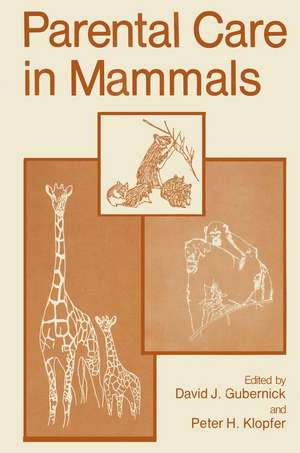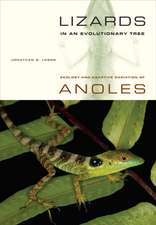Parental Care in Mammals
Editat de David J. Gubernicken Limba Engleză Paperback – 13 oct 2011
Preț: 897.81 lei
Preț vechi: 1094.89 lei
-18% Nou
Puncte Express: 1347
Preț estimativ în valută:
171.82€ • 179.15$ • 142.80£
171.82€ • 179.15$ • 142.80£
Carte tipărită la comandă
Livrare economică 20 martie-03 aprilie
Preluare comenzi: 021 569.72.76
Specificații
ISBN-13: 9781461331520
ISBN-10: 1461331528
Pagini: 484
Ilustrații: XX, 460 p. 10 illus.
Dimensiuni: 152 x 229 x 27 mm
Greutate: 0.64 kg
Ediția:1981
Editura: Springer Us
Colecția Springer
Locul publicării:New York, NY, United States
ISBN-10: 1461331528
Pagini: 484
Ilustrații: XX, 460 p. 10 illus.
Dimensiuni: 152 x 229 x 27 mm
Greutate: 0.64 kg
Ediția:1981
Editura: Springer Us
Colecția Springer
Locul publicării:New York, NY, United States
Public țintă
ResearchDescriere
The editors of this volume have honored me by their invitation to write its Fore word, an invitation extended because of my editing a book on the maternal behav ior of mammals in 1963. Much as I would like to think that I had opened a new area of study-and so played some part in the appearance of this fine new collec tion of chapters-the facts are quite otherwise. That in 1963 I could assemble the efforts of many distinguished investigators shows that the topic had already engaged their attention, and had for some years past. But even then, the topic had origins extending much farther into the past, to mention only Wiesner and Sheard's book Maternal Behavior in the Rat of 1933. Nevertheless, in 1963 it seemed to me that the study of maternal care in mammals had lagged behind the study of other kinds of social behavior. The present volume does much to establish parental care of the young as a topic central to an understanding of the relation between ontogeny and phylogeny, to the development of the young, to the social organization of the species, and to its preservation. It may now be seen not only as interesting but as a most signifi cant pattern of behavior among mammals.
Cuprins
1 Origins of Parental Care.- 1. Parental Care Is Widespread.- 2. Factors Influencing Parental Care Strategy.- 2.1. r and K Selection.- 2.2. Phyletic Continuity and Morphological Constraints.- 3. Patterns of Parenting.- 4. Adaptiveness and Patterns of Parental Care.- References.- 2 Factors Governing the Onset and Maintenance of Maternal Behavior among Nonprimate Mammals: The Role of Hormonal and Nonhormonal Factors.- 1. Onset of Maternal Behavior.- 1.1. Hormonal Regulation of Pregnancy.- 1.2. Hormonal Stimulation of Maternal Behavior.- 2. The Regulation of Postpartum Maternal Behavior.- 3. Maternal Behavior in Nonpregnant Females.- 4. Transition in the Regulation of Maternal Behavior between the Onset and Maintenance Phases.- 5. Maternal Aggression: Pre- and Postpartum Regulation.- 6. Concluding Remarks.- References.- 3 Parental Contributions to the Development of Their Offspring.- 1. Introduction.- 2. Strategies for Demonstrating Long-Term Parental Effects on Development of Young.- 2.1. Maternal Deprivation.- 2.2. Selective Breeding.- 2.3. Stressed Parents.- 2.4. Premature Separation.- 2.5. Interspecies Parenting.- 2.6. Effects Visited upon Subsequent Generations.- 3. The Prenatal Relationship.- 4. The Postnatal Relationship.- 4.1. Facial Communication in Blind Infants.- 4.2. Levels of Stimulation and Infant Behavioral Arousal.- 4.3. Regulation of Rhythmic Functions of the Infant.- 4.4. Regulation of the Onset of Puberty.- 4.5. Regulation of Infant Autonomic Function.- 4.6. Regulation of Brain Enzymes and Growth.- 5. Implications for Aberrant Development.- 5.1. Maternal Separation Revisited.- 5.2. Self-Correcting Tendencies.- 6. Conclusion.- References.- 4 Offspring Effects upon Parents.- 1. Introduction.- 2. Phylogenesis: Inclusive Fitness and Parental Investment.- 2.1. Inclusive Fitness and the Cost of Parental Investment.- 2.2. Sex Differences in Parental Responsiveness.- 3. Function: Social Consequences and Ecological Correlates of Parenting.- 3.1. Kin, the “Con,” and Contractual Obligations.- 3.2. Ecological and Social Correlates.- 4. Changes during the Life Cycle.- 4.1. Age-Related Changes.- 4.2. Prior Experience.- 5. Mechanisms: Effects of Offspring on Parental Responsiveness.- 5.1. The Setting as a Determinant of Offspring Effects.- 5.2. Effects of Offspring upon Parental State.- 5.3. Comment.- 6. Stimulus Effects of Offspring.- 6.1. Age- and Sex-Related Signals Controlling Parenting.- 6.2. Analysis According to Sensory Modality.- 7. Filial Behavior.- References.- 5 Maternal Aggression in Mammals.- 1. Introduction.- 2. Some Naturalistic Observations of Maternal Aggression.- 3. Laboratory Studies of Maternal Aggression.- 3.1. Topography of Maternal Aggression.- 3.2. Stimuli Eliciting Maternal Aggression.- 3.3. Experiential Influences on Maternal Aggression.- 3.4. Psychobiological Determinants of Mater Aggression.- 4. A Psychobiological Model of Maternal Aggression in the Mouse.- 4.1. Substrate Preparation Phase (Conception to Parturition).- 4.2. Postpartum Initiation Phase (Parturition to Postpartum Day 2).- 4.3. Postpartum Maintenance Phase (Postpartum Days 2-21).- 5. Relationship to Defense of Young and Population Dynamics.- 6. General Conclusions.- References.- 6 The Ecology of Weaning: Parasitism and the Achievement of Independence by Altricial Mammals.- 1. An Overview of Weaning.- 1.1. Mother-Young Interaction.- 1.2. Development of Behavior.- 1.3. Parasitism: An Analogy to the Life Strategy of the Altricial Juvenile Mammal.- 2. The Rat Pup as Parasite.- 2.1. The Environment Provided by the Host: Parental Investment by the Dam.- 2.2. The Rat Pup as Obligate, Passive Ectoparasite—Day 5 Postpartum.- 2.3. The Rat Pup as Facultative, Active Ectoparasite—Day 18 Postpartum.- 2.4. The Juvenile Rat as Commensal—Day 40 Postpartum.- 3. Conclusion.- References.- 7 Parent and Infant Attachment in Mammals.- 1. Introduction.- 2. What is Attachment?.- 2.1. Criteria of Attachment.- 3. Attachment and Separation.- 4. Why Form an Attachment?.- 4.1. Function of Attachment.- 5. Where Is Attachment Found?.- 5.1. Solitary Social Structure.- 5.2. Family.- 5.3. Extended Family.- 5.4. Matriarchy.- 5.5. Harem.- 5.6. Allied Females (Unrelated).- 5.7. Multimale/Multifemale Groups.- 5.8. Comment on a Scheme.- 6. Mechanisms of Parent and Infant Attachment: Selected Examples.- 6.1. Rodents.- 6.2. Primates.- 6.3. Ungulates.- 6.4. Mechanisms of Parent and Infant Attachment: Summary.- 7. Concluding Remarks.- References.- 8 Mammalian Sibling Interactions: Genes, Facilitative Environments, and the Coefficient of Familiarity.- 1. Introduction.- 2. Conditions Favoring Sibling Interaction.- 2.1. Litter Size and Mortalityt.- 2.2. Altricial versus Precocial Young.- 2.3. Intact Litters.- 2.4. “Closed” Social Groups.- 3. Sibling Recognition and the Coefficient of Familiarity: Does $$\overline {{X_r}} = 1/2\bar X$$ Anything?.- 3.1. The f Factor and Sibling Recognition.- 3.2. Probabilistic Sibling Recognition and Some Predi Species Differences.- 3.3. Does Familiarity Breed Contempt?.- 4. What Do Siblings Do?.- 4.1. Nursing Orders.- 4.2. Social Play, Cooperation, and Play Fighting.- 4.3. Sibling Competition and “Selfishness”.- 5. Alloparental Care.- 5.1. Differential Dispersal, Individual Decisions, and Food.- 5.2. Suppressed Maturation and Reproduction.- 6. Parents and Siblings.- 6.1. How Can Parents Influence Sibling Interactions?.- 7. Conclusions.- References.- 9 The Evolution of Male Parental Investment in Mammals.- 1. Introduction.- 1.1. The Definition of Male Parental Investment.- 1.2. Categories of Male Parental Investment.- 1.3. Measuring Male Parental Investment.- 1.4. The Available Data on Male Parental Investment.- 2. Results.- 2.1. What Can Male Mammals Do?.- 2.2. What Do Male Mammals Do?.- 3. Discussion.- 3.1. Phylogenetic Considerations.- 3.2. Factors That May Predispose Male Mammals to Care Young.- 3.3. The Role of Male Parental Investment in Molding the Social Organization of Species.- 4. Conclusions.- References.- 10 Primate Infant Caregiving Behavior: Origins, Consequences, and Variability with Emphasis on the Common Indian Langur Monkey.- 1. Introduction.- 2. The Context of Primate Parenting Behavior: What Makes the Primates Different?.- 3. Indian Langurs: A Case Study in Maternal Care.- 3.1. Classification.- 3.2. Social Organization.- 3.3. Langur Infant-Caretaking Patterns: Who Does It?.- 3.4. Forms of Infant Tranfers.- 4. Why Allomothering.- 5. Separating Functions, Benefits, and Origins in Evolutionary Explanations.- 5.1. Levels of Explanation.- 5.2. Function, Benefit, Effects and Origins: What Are Distinctions?.- 5.3. The “Origins” of Allomothering: Ultimate Considerations.- 6. Langur Allomothering Behavior: Is It Unique?.- 7. Parental Investment: How Much Is Too Much?.- 8. Opportunism and Adaptation: Some Theoretical Considerations.- References.- 11 The Social Context of Parental Behavior: A Perspective on Primate Socialization.- 1. Introduction.- 2. The Ontogeny of Specific Attachments: Establishment and Maintenance of Maternal Behavior in the Context of the Mother-Infant Bond.- 2.1. Birth.- 2.2. The Infant’s Behavior at Birth.- 2.3. Behavior of the Mother toward the Neonate.- 2.4. The Infant as a Stimulus for Caretaking.- 2.5. Establishment of the Mother-Infant Bond.- 2.6. Recognition of the Mother and Specificity of Partner Response.- 3. The Role of the Mother’s Past and Present Social History.- 3.1. Maternal Rank.- 3.2. Maternal Parity.- 3.3. Social Rearing History of the Mother.- 3.4. The Absence of the Mother: Mother-Infant Separation.- 3.5. Interspecific Variations in Maternal Care: A Congeneric Example.- 4. The Role of Other Socializing Agents.- 4.1. “Aunting”.- 4.2. Caretaking by Males.- 4.3. Peer Groups.- 4.4. Kinship Groups.- 4.5. Isolation of the Mother-Infant Dyad.- 5. Recapitulation: Infant Socialization and an Analysis of the “Adequate Social Rearing Environment”.- References.






